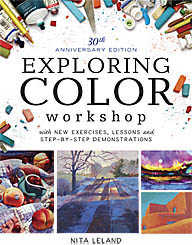Book reviews on pouring watercolors
 Jean Grastorf's Pouring Light: Layering Transparent Watercolor focuses entirely on pouring without tricks and experimental techniques. Grastorf's demos are very well done. One of the later demos, "Shell Beach," would have made a good first demo of the processes. The opening pages on supplies and materials are thorough. I like her take on design, too. She works with a very limited palette of three colors in most paintings and has an excellent chapter on color (color wheel with yellow at the top. Yay!). Note well her excellent pages on value studies. She describes the masking techniques clearly, but you must pay attention in every demo to how the process works, otherwise you may get "mud" if the colors mingle too much or the pours are of too heavy consistency. This is in my opinion the best of the three books for breaking down the pouring process into doable sequences.
Jean Grastorf's Pouring Light: Layering Transparent Watercolor focuses entirely on pouring without tricks and experimental techniques. Grastorf's demos are very well done. One of the later demos, "Shell Beach," would have made a good first demo of the processes. The opening pages on supplies and materials are thorough. I like her take on design, too. She works with a very limited palette of three colors in most paintings and has an excellent chapter on color (color wheel with yellow at the top. Yay!). Note well her excellent pages on value studies. She describes the masking techniques clearly, but you must pay attention in every demo to how the process works, otherwise you may get "mud" if the colors mingle too much or the pours are of too heavy consistency. This is in my opinion the best of the three books for breaking down the pouring process into doable sequences. How to Make a Watercolor Paint Itself by Nita Engle is subtitled: "Experimental Techniques for Achieving Realistic Effects." Nita Engle is the Grande Dame of masking-and-pouring in watercolor. Her paintings are far more complex than Grastorf's and Wallake's and create an illusion that is almost photographic without being filled with picky detail. Her palette is unique and she is the absolute master of her colors. She sprays water, throws and squirts paint, spatters, floats and pours colors in sequences for special effects, after having masked key lights and white areas on the paper. This is a text-heavy book loaded with information as well as technique, but well worth the concentration it takes to work it out. Her watercolors are magnificent. I love this book for intermediate to advanced watercolor painters.
How to Make a Watercolor Paint Itself by Nita Engle is subtitled: "Experimental Techniques for Achieving Realistic Effects." Nita Engle is the Grande Dame of masking-and-pouring in watercolor. Her paintings are far more complex than Grastorf's and Wallake's and create an illusion that is almost photographic without being filled with picky detail. Her palette is unique and she is the absolute master of her colors. She sprays water, throws and squirts paint, spatters, floats and pours colors in sequences for special effects, after having masked key lights and white areas on the paper. This is a text-heavy book loaded with information as well as technique, but well worth the concentration it takes to work it out. Her watercolors are magnificent. I love this book for intermediate to advanced watercolor painters.  Jan Fabian Wallake's Watercolor: Pour It On is subtitled: "Let Your Creativity Flow Using Dramatic Color Glazing Techniques." The book has many demos and varied illustrations of creative watercolor techniques. Wallake describes at least thirty techniques and texture washes. There is a good section touching on design with rudimentary color (and a skewed color wheel, which drives me nuts). Wallake shows a palette arrangement similar to that of Nita Engle. There isn't as much detail on pouring in Wallake's work as there is in Grastorf's and Engle's. Both of the latter have more subtlety in their work, but Wallake does love vibrant color. Along with an index, there is useful information on showing and selling your work. The author's explanations are clear and illustrations are instructive. The book is very user friendly and helpful to artists who want to loosen up their watercolor techniques.
Jan Fabian Wallake's Watercolor: Pour It On is subtitled: "Let Your Creativity Flow Using Dramatic Color Glazing Techniques." The book has many demos and varied illustrations of creative watercolor techniques. Wallake describes at least thirty techniques and texture washes. There is a good section touching on design with rudimentary color (and a skewed color wheel, which drives me nuts). Wallake shows a palette arrangement similar to that of Nita Engle. There isn't as much detail on pouring in Wallake's work as there is in Grastorf's and Engle's. Both of the latter have more subtlety in their work, but Wallake does love vibrant color. Along with an index, there is useful information on showing and selling your work. The author's explanations are clear and illustrations are instructive. The book is very user friendly and helpful to artists who want to loosen up their watercolor techniques.Labels: artist, book reviews, books, color wheel, value, watercolor techniques





0 Comments:
Post a Comment
<< Home